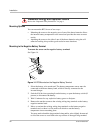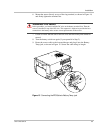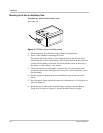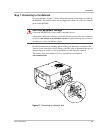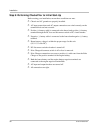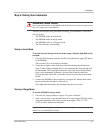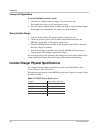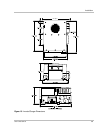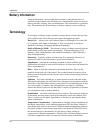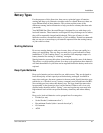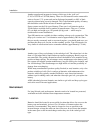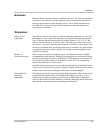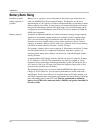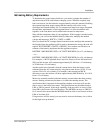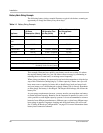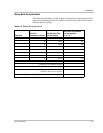
Installation
40 975-0126-02-01
Battery Information
“Battery Information” discusses the physical make-up and characteristics of
chemical storage batteries and will help you to understand the factors involved in
battery selection, charging, care, and maintenance. This information is a guideline
only. The manufacturer of each battery is the best authority on its use and care.
Terminology
A description of battery charger operation requires the use of terms that you may
not be familiar with. The following terms appear throughout the guide.
Deep Cycle A deep cycle occurs when a battery is discharged to less than 50%
of its capacity (50% depth of discharge). A deep-cycle battery is one that is
intended to be deeply discharged and charged repeatedly.
Depth of Discharge (DOD) The amount of energy or charge removed from the
battery bank, usually expressed as a percentage. A depth of discharge of 0%
indicates a fully-charged battery, and a depth of discharge of 100% indicates a
fully-discharged battery.
Electrolyte Typically sulfuric acid and water. It is commonly referred to as
battery acid, and it is the fluid inside a typical lead-acid battery.
Equalization A deliberate overcharge designed to reduce sulfation and
stratification in flooded (or wet) lead-acid batteries. Not necessary and harmful on
Gel or sealed batteries.
Plates Made of lead and connected to the battery terminals. These are the
terminals inside each cell of the battery. The essential chemical reactions of the
battery occur at the plates, and they are the source of the current/voltage produced
by the battery.
Sulfation As a battery discharges, its plates become covered with lead sulfate.
With regular recharging, the lead sulfate leaves the plates and recombines with the
electrolyte. If the lead sulfate remains on the plates for an extended period of time
(over two months), it hardens, and recharging does not remove it. Sulfation
reduces the effective plate area and the battery’s capacity. Equalization of flooded
(or wet) batteries helps to reduce sulfation.
Stratification Over time, electrolyte tends to separate. The electrolyte at the top
of the battery becomes watery while it becomes more acidic at the bottom. This
effect is corrosive to the plates. Equalization of flooded (or wet) batteries helps
reduce stratification.
Temperature Compensation Optimal battery charging voltage is dependent on
the battery temperature. As the ambient temperature falls, the proper voltage for
each charge stage needs to be increased. When the ambient temperature increases,
the proper voltage for each charge stage needs to be decreased. (The BTS allows
the inverter/charger to automatically rescale charge-voltage settings to
compensate for ambient temperatures.) The hot, cold, and warm settings are used
if a battery temperature sensor is not present. The hot setting is the default.



